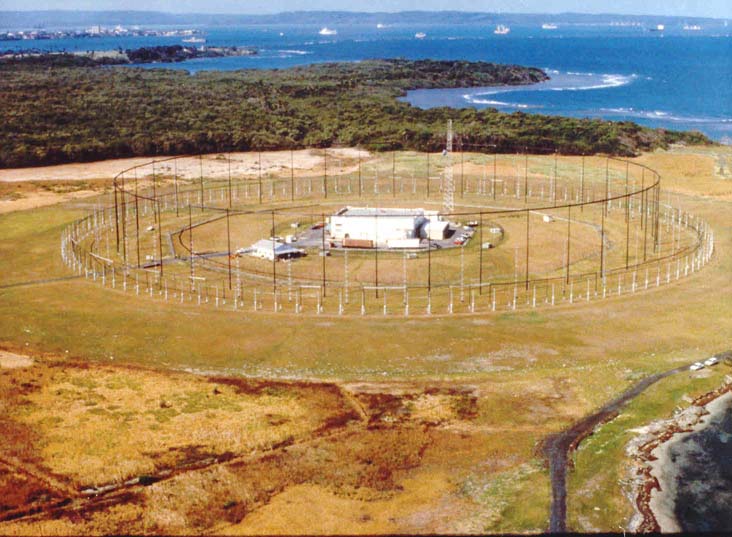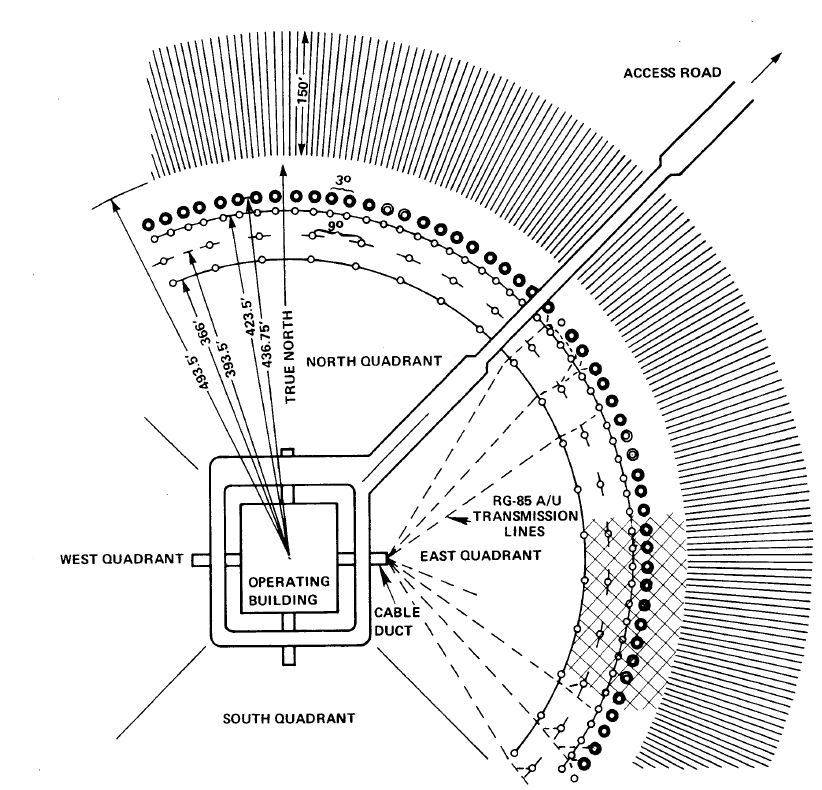|
Wullenweber
The Wullenweber (the original name introduced by Dr. Hans Rindfleisch was Wullenwever) is a type of Circularly Disposed Antenna Array (CDAA) sometimes referred to as a Circularly Disposed Dipole Array (CDDA). It is a large circular antenna array used for radio direction finding. It was used by the military to triangulate radio signals for radio navigation, intelligence gathering and search and rescue. Because its huge circular reflecting screen looks like a circular fence, the antenna has been colloquially referred to as the ''elephant cage.'' The term ''wullenwever'' was the World War II German cover term used to identify their secret CDAA research and development program; its name is unrelated to any person involved in the program. History Origin in World War II Germany Wullenweber technology was developed by the German navy communication research command, Nachrichtenmittelversuchskommando (NVK) and Telefunken during the early years of World War II. The inventor was NVK gro ... [...More Info...] [...Related Items...] OR: [Wikipedia] [Google] [Baidu] |
AN/FRD-10
The AN/FRD-10 Circularly Disposed Antenna Array (CDAA) is a United States Navy circular "Wullenweber" antenna array, built at a number of locations during the cold war for high frequency radio direction finding (HF/DF) and signals intelligence. In the Joint Electronics Type Designation System, FRD stands for ''fixed ground, radio, direction'' finding. 14 sites were originally constructed as a part of the "Classic Bullseye" program. Two AN/FRD-10 systems were later installed in Canada. AN/FRD-10 systems were originally constructed in the early 1960s, but after the dissolution of the Soviet Union, the systems began to be shut down and demolished. The Naval Security Group operated and maintained the U.S. Navy AN/FRD-10 systems. The system had several nicknames including ''Fred-10'' and ''Elephant'' or ''Dinosaur cages''. As of 2015, none of the US Navy AN/FRD-10 sites are extant, but the two Canadian sites remain in service. The AN/FLR-9 was a system with a similar design and functio ... [...More Info...] [...Related Items...] OR: [Wikipedia] [Google] [Baidu] |
USASA Field Station Augsburg
United States Army Security Agency (USASA) Field Station Augsburg was the site of a Wullenweber AN/FLR-9 (V8) radio direction finder, established during the Cold War. Field Station Augsburg was located on Gablingen Kaserne, near the village of Gablingen just north of Augsburg in Bavaria, West Germany. It was one of nearly 20 field stations positioned strategically around the world by the U.S. Armed Forces during the Cold War. Field Station Augsburg opened in 1970 and closed in 1998, at which time it was turned over to the German government. The Station was owned and managed by the National Security Agency and staffed by the U.S. Army Security Agency (USASA), which later became U.S. Army Intelligence and Security Command (INSCOM), in conjunction with other branches of the U.S. Military and various allied forces. Personnel assigned to Field Station Augsburg were composed[ of individuals who scored high enough on the Army entrance exams to be classified as "ST" or a skilled techn ... [...More Info...] [...Related Items...] OR: [Wikipedia] [Google] [Baidu] |
AN/FLR-9
The AN/FLR-9 is a type of very large circular "Wullenweber" antenna array, built at eight locations during the cold war for HF/DF direction finding of high priority targets. The worldwide network, known collectively as "Iron Horse", could locate HF communications almost anywhere on Earth. Because of the exceptionally large size of its outer reflecting screen (1056 vertical steel wires supported by 96 towers), the FLR-9 was commonly referred to by the nickname "Elephant Cage." Constructed in the early to mid 1960s, in May 2016 the last operational FLR-9 at Joint Base Elmendorf-Richardson in Alaska was decommissioned. It can be confused with the US Navy's AN/FRD-10, which also used a Wullenweber antenna. Description The ''AN/FLR-9 Operation and Service Manual'' describes the array as follows: The antenna array is composed of three concentric rings of antenna elements. Each ring of elements receives RF signals for an assigned portion of the 1.5 to 30-MHz radio spectrum. The o ... [...More Info...] [...Related Items...] OR: [Wikipedia] [Google] [Baidu] |
HF/DF
High-frequency direction finding, usually known by its abbreviation HF/DF or nickname huff-duff, is a type of radio direction finder (RDF) introduced in World War II. High frequency (HF) refers to a radio band that can effectively communicate over long distances; for example, between U-boats and their land-based headquarters. HF/DF was primarily used to catch enemy radios while they transmitted, although it was also used to locate friendly aircraft as a navigation aid. The basic technique remains in use to this day as one of the fundamental disciplines of signals intelligence, although typically incorporated into a larger suite of radio systems and radars instead of being a stand-alone system. Earlier systems used a mechanically rotated antenna or solenoid and an operator listening for peaks or nulls in the signal, which often took considerable time to determine the bearing on the order of a minute or more. Later systems used a set of antennas to receive the same signal in slig ... [...More Info...] [...Related Items...] OR: [Wikipedia] [Google] [Baidu] |
Elmendorf AFB
Elmendorf Air Force Base is a United States Air Force (USAF) facility in Anchorage, Alaska. Originally known as Elmendorf Field, it became Elmendorf Air Force Base after World War II. It is the home of the Headquarters, Alaskan Air Command (ALCOM), Alaskan NORAD Region (ANR), Eleventh Air Force (11 AF), the 673d Air Base Wing, the 3rd Wing, the 176th Wing and other tenant units. In 2010 it was amalgamated with nearby Fort Richardson to form Joint Base Elmendorf-Richardson. The adjacent facilities were officially combined by the 2005 Base Closure and Realignment Commission. Its mission is to support and defend U.S. interests in the Asia-Pacific region and around the world by providing units who are ready for worldwide air power projection and a base that is capable of meeting United States Pacific Command's theater staging and throughput requirements. Units The installation hosts the headquarters for the United States Alaskan Command, 11th Air Force, U.S. Army Alaska, and ... [...More Info...] [...Related Items...] OR: [Wikipedia] [Google] [Baidu] |
CDAA Elmendorf AFB
CDAA may refer to: * Cave Divers Association of Australia Inc. - an association that represents Australian recreational cave divers. * Circularly Disposed Antenna Array - a large circular antenna used by the military {{disambig ... [...More Info...] [...Related Items...] OR: [Wikipedia] [Google] [Baidu] |
RAF Chicksands
Ministry of Defence Chicksands or more simply MoD Chicksands is a UK Ministry of Defence station located 7.7 miles (12.4 km) south east of Bedford, Bedfordshire and 11.6 miles (18.7 km) north east of Luton, Bedfordshire. Now the location of the Defence Intelligence and Security Centre (DISC), it was previously named RAF Chicksands. It closed in 1997 when responsibility for the camp was taken over by the British Army Intelligence Corps. Near the town of Shefford it is named after Chicksands Priory, a 12th-century Gilbertine monastery located within the perimeter of the camp. Site history The Crown Commissioners bought the Chicksands estate on 15 April 1936, later renting it to Gerald Bagshawe, who lived there until it was requisitioned by the Royal Navy. After nine months the RAF took over operations and established a signal intelligence collection (SIGINT) unit there, known as a Y Station. The site operated as a SIGINT collection site throughout the Second World War ... [...More Info...] [...Related Items...] OR: [Wikipedia] [Google] [Baidu] |
CFB Gander
Canadian Forces Base Gander (also CFB Gander, ), is a Canadian Forces base located in Gander, Newfoundland and Labrador. It is operated as an air force base by the Royal Canadian Air Force and is home to search and rescue operations that cover a vast swath of the western North Atlantic and southern Arctic and a Canadian Coastal Radar station amongst other things. It is home to 9 Wing Gander. CFB Gander is co-located at Gander International Airport. RCAF Station Gander The Newfoundland Airport was established by the Dominion of Newfoundland in 1936 and it became a strategically important airfield for piston-engined aircraft in the late 1930s. Shortly after World War II was declared, the Government of Newfoundland turned the operation of the airfield over to the Royal Canadian Air Force (RCAF) in 1940, which had been tasked by the United Kingdom the responsibility to provide aerial defence for the dominion. The No. 10 Bomber and Reconnaissance (BR) Squadron began operating from ... [...More Info...] [...Related Items...] OR: [Wikipedia] [Google] [Baidu] |
Radio Direction Finding
Direction finding (DF), or radio direction finding (RDF), isin accordance with International Telecommunication Union (ITU)defined as radio location that uses the reception of radio waves to determine the direction in which a radio station or an object is located. This can refer to radio or other forms of wireless communication, including radar signals detection and monitoring (ELINT/ESM). By combining the direction information from two or more suitably spaced receivers (or a single mobile receiver), the source of a transmission may be located via triangulation. Radio direction finding is used in the navigation of ships and aircraft, to locate emergency transmitters for search and rescue, for tracking wildlife, and to locate illegal or interfering transmitters. RDF was important in combating German threats during both the World War II Battle of Britain and the long running Battle of the Atlantic. In the former, the Air Ministry also used RDF to locate its own fighter ... [...More Info...] [...Related Items...] OR: [Wikipedia] [Google] [Baidu] |
Hjørring
Hjørring () is a town on the island of Vendsyssel-Thy at the top of the Jutland peninsula in northern Denmark. It is the main town and the administrative seat of Hjørring Municipality in the North Jutland Region. The population is 25,644 (according to an official census carried on 1 January 2022).BY3: Population 1. January by urban areas, area and population density The Mobile Statbank from It is also one of Denmark's oldest towns, having celebrated its 750th anniversary as a market town in 1993. Hjørring is centrally located in a sparsely populated area and serves as an urban center for large parts of especially the western and ce ... [...More Info...] [...Related Items...] OR: [Wikipedia] [Google] [Baidu] |
San Vito Dei Normanni Air Station
San Vito dei Normanni Air Station was a United States Air Force facility located west of Brindisi, Apulia, between the port of Brindisi and the town of San Vito dei Normanni, Italy. 1960 - Base activated Staffed by the 7275th Air Base Group, San Vito AB began as an off-base installation of Aviano Air Base with support personnel and equipment furnished by the 6900th Security Wing in 1960. It became a primary installation on 1 March 1961. operated since its activation by the United States Air Force Security Service (USAFSS). 1964 - High frequency monitoring array In 1964, a HF monitoring/receiving system of a large circular antenna array for COMINT purposes was installed. This AN/FLR-9 receiving system was operational until October 1994. 1979 - 6917th Electronic Security Group On 1 October 1979, the base reverted to HQ Sixteenth AF (USAFE), hosting the 6917th Electronic Security Group and other assigned U.S. and Allied units and organizations. 1990 - Air Force Space Command es ... [...More Info...] [...Related Items...] OR: [Wikipedia] [Google] [Baidu] |
Miho
is a feminine Japanese given name and a masculine Croatian name. It can have many different meanings in Japanese depending on the kanji used. Possible Japanese writings Miho can be written using different kanji characters and can mean: *実穂, "truth, ear of grain" *美穂, "beauty, ear of grain" *美保, "beauty, care" *未歩, "future (part of the word 未来), step" *美帆, "beauty, sail" *美歩, "beauty, walk" The name can also be written in hiragana "みほ" or katakana “ミホ”. People with the name * , Japanese sprint canoeist * , Japanese voice actress * Miho Bošković (born 1983), Croatian water polo player * Miho Dukov (, born 1955), former Bulgarian wrestler * , Japanese actress * , Japanese singer * , Japanese football player * , Japanese table tennis player * , Japanese singer and songwriter * , Japanese composer and jazz musician * Miho Iwata (born 1962), Japanese performance artist, scenographer and choreographer * , former Japanese football player * ... [...More Info...] [...Related Items...] OR: [Wikipedia] [Google] [Baidu] |





_aero_chart.png)

